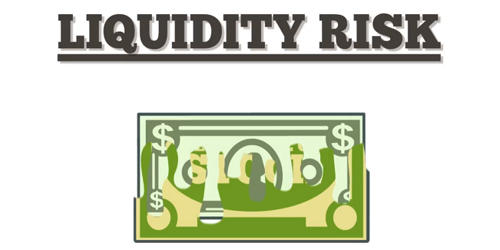Liquidity risk is the risk that a company or bank may be unable to meet short term financial demands. It is a financial risk that for a certain period of time a given financial asset, security, or commodity cannot be traded quickly enough in the market without impacting the market price. This usually occurs due to the inability to convert a security or hard asset to cash without a loss of capital and/or income in the process. This usually occurs as a result of a firm’s inability to convert its current assets into cash without incurring capital losses.
Types
Market liquidity – Market or asset liquidity risk is asset illiquidity or the inability to easily exit a position. An asset cannot be sold due to a lack of liquidity in the market – essentially a sub-set of market risk. This can be accounted for by:
- Widening bid/offer spread
- Making explicit liquidity reserves
- The lengthening holding period for VaR calculations
Funding liquidity – Funding or cash flow liquidity risk is the chief concern of a corporate treasurer who asks whether the firm can fund its liabilities. The risk that liabilities:
- Cannot be met when they fall due
- Can only be met at an uneconomic price
- Can be name-specific or systemic
Market liquidity risk can be measured by bid-ask spread, market depth, immediacy, and resilience. Fund liquidity risk can be measured by the current ratio, which divides current assets by current liabilities, or by the quick ratio.
Causes
Liquidity risk arises from situations in which a party interested in trading an asset cannot do it because nobody in the market wants to trade for that asset. Inability to meet short-term debt due to exceptional losses or damages during Operations. Liquidity risk becomes particularly important to parties who are about to hold or currently hold an asset since it affects their ability to trade.
Liquidity risk generally arises when a business or individual with immediate cash needs, holds a valuable asset that it can not trade or sell at market value due to a lack of buyers, or due to an inefficient market where it is difficult to bring buyers and sellers together.
A manifestation of liquidity risk is very different from a drop in price to zero. In case of a drop of an asset’s price to zero, the market is saying that the asset is worthless. This is why liquidity risk is usually found to be higher in emerging markets or low-volume markets.
Liquidity risk is a financial risk due to uncertain liquidity. An institution might lose liquidity if its credit rating falls, it experiences sudden unexpected cash outflows, or some other event causes counterparties to avoid trading with or lending to the institution. In the context of funding, liquidity risk refers to the ability of institutions to fund liabilities as they fall due without incurring losses through being forced to sell less-liquid assets quickly.
















